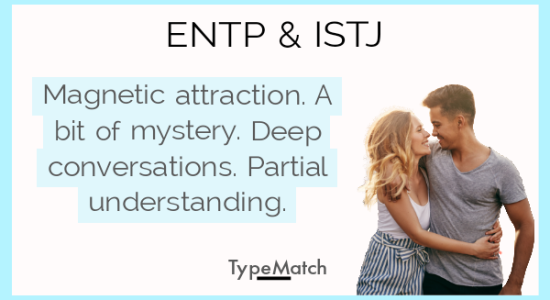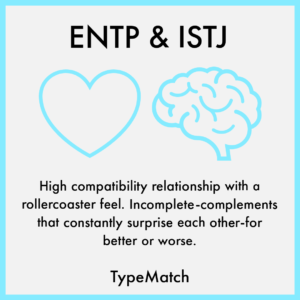ENTP and ISTJ Relationship
Are ENTP and ISTJ Relationships Compatible?
ENTP and ISTJ relationships start with magnetic attraction as the two seem mysterious to each other. TypeMatch rates these relationships as having high compatibility in our free TypeMatch dating and friendship app based on personality type. Below we explain what makes ENTP and ISTJ relationships great but not without their challenges.
ENTP and ISTJ Attraction
ENTPs and ISTJs are often instantly attracted to each other and find each other fascinating. They only partially understand each other, which makes them endlessly intriguing to each other and makes them magnets for each other. To each one, it seems like the other is being purposefully mysterious and holding back something important. They love to surprise each other and be flirty and romantic in this way.
ENTP and ISTJs are called incomplete complements because they only half understand each other. While they strongly attract each other, they have trouble moving their relationship to the next level. Each sees some things they like and dislike about their partner’s behavior, but they don’t openly communicate about them. As a result, the relationship takes a long time to establish.
ENTP and ISTJ Communication
ENTPs and ISTJs can talk for hours and never get tired of each other. They have endless topics of discussion and have conversations that are deep and interesting for both of them. According to Socionics, there is trouble with communication in that the ENTP doesn’t fully listen to the ISTJ but continues on their own path in the conversation. However, the ISTJ isn’t offended and adapts to the ENTP’s style. In their conversations, both respect and preserve their individual viewpoints. They also give each other important insights that the other may have missed in their limited view, thus mutually expanding their perspectives. For this couple, the more time they spend together, the more they find there is so much more to learn.
Dating an ENTP can be magical and fun but also challenging and frustrating. This type is notoriously hard to understand and hides themselves in shadows of mystery. It’s clear that dating the ENTP isn’t for the faint of heart. So, we’ve put together a guide to dating the ENTP with our top 19 pieces of practical advice. Click here to download our ENTP dating guide!

Rollercoaster Relationship
ENTP and ISTJ relationships have an unpredictable and volatile quality that makes them feel like an emotional rollercoaster at times. They exist in a constant flux of calm and chaos as arguments tend to happen out of nowhere as one person does something that throws the relationship backward. As a result, they have trouble getting as close as they would like and moving things forward. They generally work well together but differences in world views and misunderstandings cause arguments. So, it’s hard for this pair to achieve a fully unified front and they lack a little bit of commitment to each other.
Luckily, ENTPs and ISTJs do not stay angry with each other for long and quickly make up after an argument. The lows also bring highs as this relationship has lots of passion. They throw each other off-balance in a way that’s exciting but never lets them completely relax. Overall, high emotional reactivity can ruin this relationship. The two must learn to regulate themselves and take short breaks to calm down before discussing and compromising.
Partnership Dynamics
When it comes to working together as partners in life, ENTPs and ISTJs struggle. The way they take action on things is different. So, each one does things that the other doesn’t expect or like. They have no trouble when it comes to planning together and understanding each other’s motivations. It’s just that when it comes to implementation, they diverge. As a result, ENTPs and ISTJs aren’t productive in moving towards their goals together. They have some mutual weaknesses and have trouble finishing projects together as they get frustrated.
Similarly, ENTPs and ISTJs have trouble fixing their problems in the relationship. They talk about them a lot but nothing really changes. They want to help each other solve problems but each one is stubborn in their own ways of doing things and doesn’t want the other’s advice. Neither understands that in trying to help, they frustrate and annoy each other.
ENTP and ISTJ Relationship Advice
Overall, as half-complements, ENTPs and ISTJs disappoint each other a bit. Both take care of themselves first and their partner second. They tend to be together but lead separate lives and have different friend groups. This can lead to trouble as others get in the way of their closeness and stability as a couple.
These two can be very compatible and have a healthy and productive relationship if they learn to work together. It’s essential for them to make an effort to maintain closeness and practicality in order to help each other and compromise. Also, ENTPs and ISTJs must get to know each other and get close slowly over time. It’s not good for them to rush into a relationship or force closeness. They have to discuss problems and frustrations immediately rather than hiding them or holding them in. Finally, to succeed as a couple they must learn to deal with issues less emotionally and more pragmatically by talking about the facts.

More Resources for ENTP & ISTJ Relationships
Dating or wanting to date an ENTP? Download our ENTP dating guide!
Are you an ENTP or ISTJ looking for your match? Try the Free TypeMatch Dating App!
Check out the relationship pages for both personality types: ENTP, ISTJ
Find out about the type’s compatibility with other personality types: free compatibility chart
Sources:
A.V. Bukalov, G. Boiko, “Why Saddam Hussein made a mistake, or what is Socionics”
Ekaterina Filatova “Art of understanding yourself and others”
Eugene Gorenko, Vladimir Tolstikov, “Nature of self”
I.D. Vaisband, publications on Socionics
Laima Stankevichyute “Intertype relations”
O.B. Slinko, “The key to heart – Socionics”
R.K. Sedih, “Informational psychoanalysis”
Sergei Ganin
Valentina Meged, Anatoly Ovcharov
V.V. Gulenko “Criteria of reciprocity”
V.V. Gulenko, A.V. Molodtsev, “Introduction to socionics”



